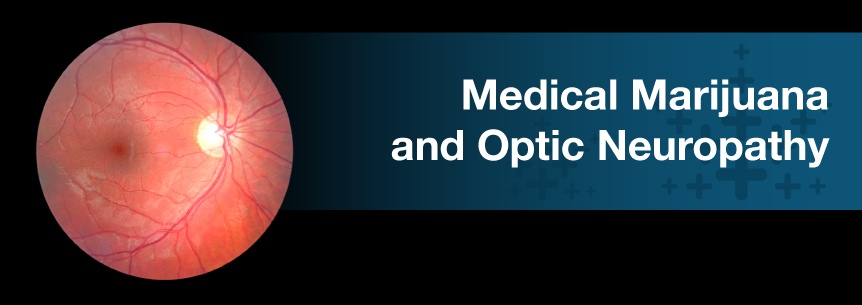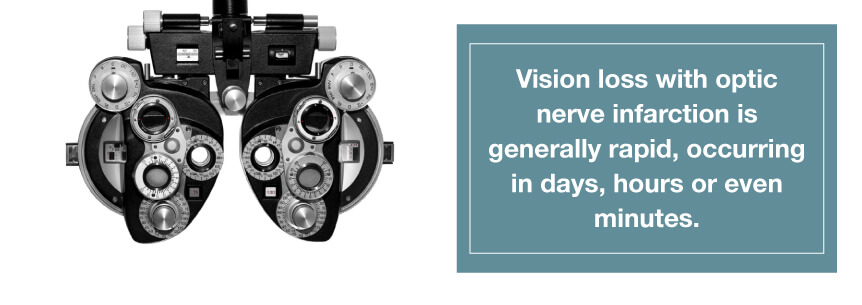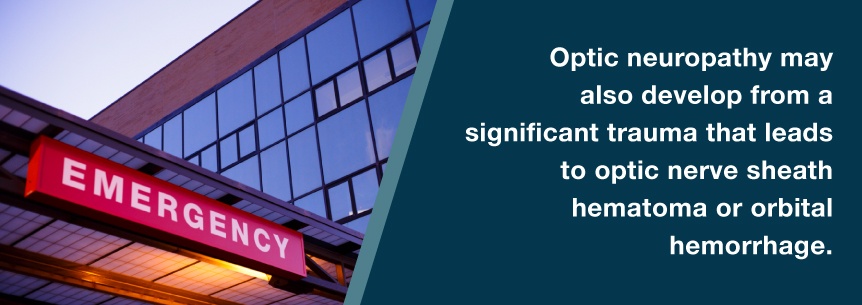
Medical cannabis has increasingly gained many people’s interest as a natural alternative treatment option for a variety of conditions and disorders. Researchers are now studying medical cannabis for optic neuropathy, and individuals are already saying it helps with many of their symptoms.
Glaucoma is among the conditions being studied to determine medical cannabis’s effect on intraocular pressure. Although scientists found THC, the plant’s active ingredient, did reduce eye pressure, it also could lower blood pressure, and this could lead to further optic nerve damage due to its blood supply being restricted. But, another study found THC helps preserve the nerves in the eyes.
Scientists are presently studying the effect cannabinoid therapies have when directly applied to the eye versus systemic administration through ingestion and inhalation. This could eliminate the potential problems surrounding reduced blood pressure-related optic nerve damage.

Also, according to the study above, THC isn’t just an anti-inflammatory. It’s also capable of preserving the nerves.
According to the National Eye Institute, medical marijuana and optic neuropathy treatment reduce the pressure within the eye. The herb lowered intraocular pressure in individuals with glaucoma and those with normal pressure when smoked, according to studies in the 1970s.
Marijuana treatment for optic neuropathy can help with symptoms such as:
Marijuana also effectively reduces chronic inflammation and inflammatory-related pain because of its two main cannabinoids, THC and CBD.
Medical weed is neuroprotective and helps control intraocular pressure. The American Academy of Ophthalmology disclosed a position statement in 2003 stating some derivatives of cannabis did lead to the lowering of intraocular pressure with oral administration, smoking or given intravenously, but not when applied topically to the eye.
Medical pot also has anti-inflammatory and painkilling properties to help relieve your optic neuropathy symptoms. Some cannabis strains work great against glaucoma attack-related nausea and vomiting.
Certain strains work well for the treatment of glaucoma. Therefore, they may be helpful for treating optic neuropathy and its symptoms. Below are some cannabis strains to try to alleviate your optic neuropathy symptoms.
CBD-rich strains appeal to individuals seeking pain relief from inflammation. Some good anti-inflammatory strains are:
Nausea and vomiting with glaucoma can be debilitating. These strains should help ease these symptoms:

Regardless of the delivery method you choose for your cannabis for optic neuropathy treatment, these strains can help reduce your eye discomfort and chronic pain:
Indica-dominant strains tend to be the better choice for insomnia treatment. They induce a calm, sleepy feeling to help you fall asleep and stay asleep. Give these strains a try:
Anxiety and depression often affect people with optic neuropathy because of its uncomfortable symptoms. Certain strains have been proven to help, including:
Today, medical marijuana often makes the perfect substitute for addictive prescription pain medications and medicines that come with adverse side effects. The herb can also help give you a better quality of life. The effects of this alternative medicinal treatment depend on the method of delivery you choose.
Some methods of cannabis delivery include:
Smoking cannabis comes with respiratory risks, and you may not be able to apply topical marijuana to your eye. You should work with your ophthalmologist and medical marijuana doctor to determine the best method of delivery for you.
It can take some experimenting before you find the right strains and methods of delivery to effectively treat your optic neuropathy symptoms with medical cannabis. Each person will differ in their experience with medical weed. While cannabis is a great way to naturally and gently alleviate your optic neuropathy symptoms, it can be confusing when you’re first starting out with your treatment.
To help with this, you should find a qualified cannabis doctor to guide you through this process and a dispensary to get your cannabis products. You can find both of these — and much more — here at MarijuanaDoctors.com.
Find A Doctor Find A Dispensary
Optic neuropathy also referred to as optic atrophy, is the last stage of numerous causes of optic nerve damage anywhere along its length between the anterior visual system (lateral geniculate body) and the retinal ganglion cells. Optic neuropathy ordinarily describes optic nerve damage or abnormalities.
The cause of optic neuropathy is often not known, but potential origins include:
Nerve cell damage and death lead to optic neuropathy’s characteristic features. Loss of vision, particularly where you see subtly washed out colors appearing in your affected eye, is the main symptom. In many instances, optic neuropathy only affects one eye, and the patients don’t even notice the color vision loss until their doctor has them cover up their healthy eye.
The mode of visual loss onset is an essential hint to the cause of the condition. Rapid onset is characteristic of:
On the other hand, gradual onset over months is characteristic of nutritional or toxic optic neuropathy.
Some people get optic neuropathy confused with optic neuritis. Optic neuritis is optic nerve inflammation caused by loss of or damage to the myelin, the protective sheath that surrounds this nerve and is vital for proper vision. Another term for this eye problem is demyelinating optic neuritis.
You are at higher risk of developing optic neuropathy if you have:
Having a risk factor, however, doesn’t necessarily mean you’ll develop the condition. The risk factors simply increase your chances of developing the disorder compared to those without any risk factors. Some risk factors are more significant than others. Additionally, not having a risk factor doesn’t necessarily mean you won’t develop the disorder either.
Age may also be a factor in certain types of optic neuropathy. Acute anterior ischemic optic neuropathy (AION) commonly presents itself in patients 50 years old or older.
The symptoms of optic neuropathy you experience will depend on what the underlying cause is, however, generally some symptoms may include:
Vision loss with optic nerve infarction is generally rapid, occurring in days, hours or even minutes. This vision loss is painless. Some individuals will wake up to this vision loss. Other symptoms some patients report are:
You may not experience these symptoms until after you’ve lost your vision. You may also experience an afferent pupillary defect and reduced visual acuity.

Some common causes of optic neuropathy are:
Glaucoma is a progressive disorder causing pressure build-up in your eyes potentially resulting in optic nerve damage. Too much pressure in your eye damages the optic nerve, the responsible nerve for sending the images you see to your brain for interpretation. The damaged nerve can then result in substantial impairment of sight or blindness in only a few years.
Retrobulbar neuritis is a type of optic nerve inflammation or optic neuritis. Inflammation, while a normal process of the immune system, can still damage healthy tissue in pathologies like autoimmune conditions. Optic nerve inflammation occurs in disorders like:
Traumatic optic neuropathy develops as a result of an indirect optic nerve injury believed to be due to impact-related transmitted shock created to the optic nerve’s intracanalicular portion. Bony optic canal fragments or penetrating injury may cause this. Optic neuropathy may also develop from a significant trauma that leads to optic nerve sheath hematoma or orbital hemorrhage.

Blockage of an eye vein involved in directing deoxygenated blood away from your eye characterizes this condition. Because of this, blood starts backing up in the eye and spills out into the retina, leading to macula swelling and affecting central vision. If your doctor doesn’t treat this abnormal blood supply, your eye’s nerve cells could die, causing permanent vision loss.
Many other conditions can cause optic neuropathy. These include:
There are many types of optic neuropathy, including:
Optic neuritis, ischemic optic neuropathy (ION) and trauma are common acute neuropathies.
The cause of your optic nerve degeneration will determine any optic neuropathy complications. In some cases, total and irreversible vision loss can occur. The nature and degree of visual loss depend on the type and severity of the underlying condition.
Glaucoma is a typical pathophysiologically heterogeneous, gradual optic neuropathy as well as one of the leading causes of total vision loss in industrialized countries. Anxiety, depression and sleep disorders are often found in glaucoma patients, although these conditions haven’t raised much scientific or clinical interest.
Research shows patients with visual impairment have a higher incidence of depression. One study suggests people with severe visual field defects (VFD) show higher rates of anxiety, depression and sleep problems when compared with the study’s control group.
Ideas about optic nerve function and anatomy in the Western world trace back in history from the ancient Greeks.
Roman and Greek humoral physiology described a hollow optic nerve, the obstacle preventing visual spirit flow to and from the brain, resulting in blindness. Medieval doctors had known that having a fixed dilated pupil meant optic nerve obstruction and prevented visual spirit passage. In such cases, the cataract surgery wouldn’t restore sight.
Although you might not be able to prevent optic neuropathy, taking certain steps could help, including:
Doctors can’t reverse optic neuropathy. The doctor must find the underlying condition and treat it. Otherwise, you will continue losing your vision.
Treatment will depend on what’s causing your optic neuropathy. If it’s due to a compressive lesion or process, your doctor will likely recommend decompression of your optic nerve as treatment. Ischemic optic neuropathy has no specific treatment other than controlling atherosclerotic risk factors.
Doctors often use steroids or immunosuppressive medications to treat autoimmune/inflammatory conditions like optic neuritis.
Some side effects of steroids include:
Increased risk of infection is the most significant side effect of immunosuppressant medications. These medications also come with less serious side effects like:
The side effects usually subside once your body starts adjusting to the immunosuppressant medications.
The severity of your underlying illness determines the outcome of your optic neuropathy. Some conditions like optic nerve inflammation, for instance, might clear up your vision problems, once the doctor treats the inflammation. Other causes, however, might not see any vision improvement at all. Early diagnosis and treatment is the most proactive thing you can do when you have an eye problem.
Through a clinical trial, researchers are conducting a study to evaluate medical marijuana’s effect on ocular parameters.
Doctors examined adult eye clinic patients who didn’t have an ocular pathology but who were receiving medical cannabis treatment in the pain clinics or neurology clinics for different indications.
The first exam was with a patient who didn’t smoke the herb for five hours. More exams were performed one hour, three hours and five hours after the patients smoked cannabis.
The doctors checked the following parameters: